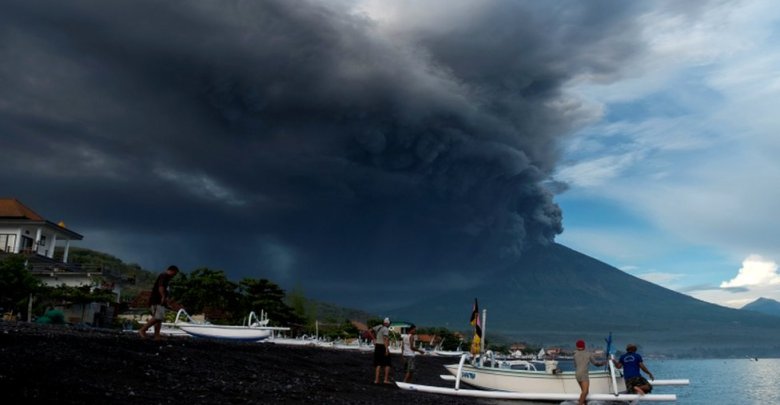About 100,000 people near Bali’s Mount Agung have been ordered to evacuate as officials fear a major eruption.
Indonesian authorities have raised the state of alert to its highest level, and expanded the exclusion zone around the rumbling volcano.
The island’s airport has now closed, leaving thousands stranded in the tourist hotspot.
Authorities say dark gas and ash have been billowing up to 3,400m (11,150ft) above the mountain’s summit.
Officials have warned residents to stay away from rock and debris flows known as lahars, which have been spotted flowing down from the mountain.
Mount Agung’s volcanic tremors first began in September.
Airport authorities said 445 flights had been cancelled, affecting 59,000 travellers, while Indonesia’s national hotel association said that stranded tourists staying at member hotels could stay one night for free.
The Australian government and the UK’s Foreign Office have advised travellers to be prepared for cancelled flights, closely monitor local media, and to heed local authorities’ warnings.
China (statement in Chinese) advised its citizens to be “cautious” if travelling to Bali.
The airport on neighbouring island Lombok reopened on Monday morning after it was shut briefly.
How are locals coping?
Authorities have widened the exclusion zone to a 10km (6 mile) radius from the volcano, and have ordered people in the area to evacuate.
On Monday, officials said about 100,000 residents needed to leave, but so far only 40,000 have done so.
A spokesman for Indonesia’s disaster agency, Sutopo Purwo Nugroho, said that some people within the exclusion zone did not leave because the area was not touched the last time it erupted – more than 50 years ago.
The volcano first began belching thick gas last week.
Officials have been distributing masks for local residents, as ash rains down in the vicinity.
Anna Baranova, who works with non-governmental organisation Kopernik that is helping evacuees, said her group was trying to bring in better masks and possibly goggles.
“There’s some effort to distribute information and also solar powered TV units which will broadcast information about the evacuation to the camps, should the electricity go out if there’s an eruption,” she told the BBC.
How close is it to a major eruption?
The National Board for Disaster Management raised the alert to level four from 06:00 local time (22:00 GMT Sunday) because of “the possibility and imminent risk of disaster”.
The volcano was seen emitting “continuous ash puffs” occasionally accompanied by “explosive eruptions” and “weak booms” that could be heard 12km (7 miles) away from the summit.
“The rays of fire are increasingly observed at night. This indicates the potential for a larger eruption is imminent,” it said in a statement (in Indonesian) on its Facebook page.
Geologist Mark Tingay of the University of Adelaide told the BBC that Mount Agung now appears to be entering the next phase with a magmatic eruption, where the glow of lava is visible from the crater.
But he added that as eruptions are difficult to predict, it was “very hard to tell” how the situation would develop. “These eruptions can be quite large and extensive and violent, but this could also be a relatively minor eruption over time.”
He added that Indonesian authorities had made preparations for an eruption for months, and said they appeared “extremely well prepared”, with the situation “well under control”.
Should tourists be worried?
The main tourist stretch of Kuta and Seminyak is about 70km (43 miles) from the volcano, far beyond the exclusion zone.
But the ash prompted officials to shut down Bali’s Ngurah Rai airport from Monday to Tuesday morning.
BBC
 Q FM Africa's Modern Radio
Q FM Africa's Modern Radio
